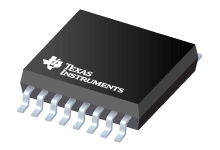Datasheet Texas Instruments THS4552IRTWR
| Manufacturer | Texas Instruments |
| Series | THS4552 |
| Part Number | THS4552IRTWR |

Dual Channel, Low-Noise, Precision, 150-MHz, Fully Differential Amplifier 24-WQFN -40 to 125
Datasheets
THS4552 Dual-Channel, Low-Noise, Precision, 150-MHz, Fully Differential Amplifier datasheet
PDF, 2.9 Mb, Revision: A, File published: Jul 19, 2017
Extract from the document
Prices
Status
| Lifecycle Status | Preview (Device has been announced but is not in production. Samples may or may not be available) |
| Manufacture's Sample Availability | No |
Packaging
| Pin | 24 | 24 |
| Package Type | RTW | RTW |
| Industry STD Term | WQFN | WQFN |
| JEDEC Code | S-PQFP-N | S-PQFP-N |
| Package QTY | 3000 | 3000 |
| Device Marking | IRTW | THS4552 |
| Width (mm) | 4 | 4 |
| Length (mm) | 4 | 4 |
| Thickness (mm) | .75 | .75 |
| Pitch (mm) | .5 | .5 |
| Max Height (mm) | .8 | .8 |
| Mechanical Data | Download | Download |
Parametrics
| 2nd Harmonic | 128 dBc |
| 3rd Harmonic | 139 dBc |
| @ MHz | 0.1 |
| Acl, min spec gain | 1 V/V |
| Additional Features | Shutdown |
| Architecture | Bipolar,Fully Differential,Voltage FB |
| BW @ Acl | 150 MHz |
| CMRR(Min) | 93 dB |
| CMRR(Typ) | 110 dB |
| Input Bias Current(Max) | 1500000 pA |
| Iq per channel(Max) | 1.44 mA |
| Iq per channel(Typ) | 1.37 mA |
| Number of Channels | 2 |
| Offset Drift(Typ) | 0.45 uV/C |
| Operating Temperature Range | -40 to 125 C |
| Output Current(Typ) | 65 mA |
| Package Group | WQFN |
| Package Size: mm2:W x L | 24WQFN: 16 mm2: 4 x 4(WQFN) PKG |
| Rail-to-Rail | In to V-,Out |
| Rating | Catalog |
| Slew Rate(Typ) | 220 V/us |
| Total Supply Voltage(Max) | 5.4 +5V=5, +/-5V=10 |
| Total Supply Voltage(Min) | 2.7 +5V=5, +/-5V=10 |
| Vn at 1kHz(Typ) | 3.3 nV/rtHz |
| Vn at Flatband(Typ) | 3.3 nV/rtHz |
| Vos (Offset Voltage @ 25C)(Max) | 0.265 mV |
Eco Plan
| RoHS | Compliant |
Design Kits & Evaluation Modules
- Evaluation Modules & Boards: THS4552RTWEVM
THS4552RTW Evaluation Module
Lifecycle Status: Active (Recommended for new designs) - Evaluation Modules & Boards: THS4552PWEVM
THS4552PW Evaluation Module
Lifecycle Status: Active (Recommended for new designs)
Application Notes
- Noise Analysis for High Speed Op Amps (Rev. A)PDF, 256 Kb, Revision: A, File published: Jan 17, 2005
As system bandwidths have increased an accurate estimate of the noise contribution for each element in the signal channel has become increasingly important. Many designers are not however particularly comfortable with the calculations required to predict the total noise for an op amp or in the conversions between the different descriptions of noise. Considerable inconsistency between manufactu
Model Line
Series: THS4552 (4)
- THS4552IPWR THS4552IPWT THS4552IRTWR THS4552IRTWT
Manufacturer's Classification
- Semiconductors > Amplifiers > Operational Amplifiers (Op Amps) > High-Speed Op Amps (>=50MHz)
